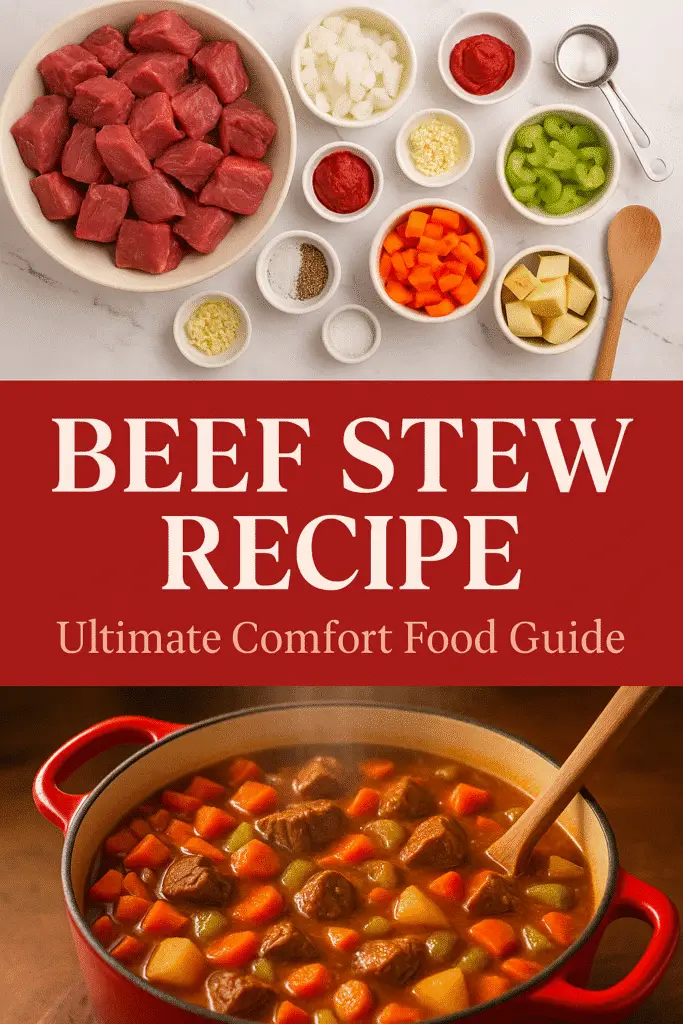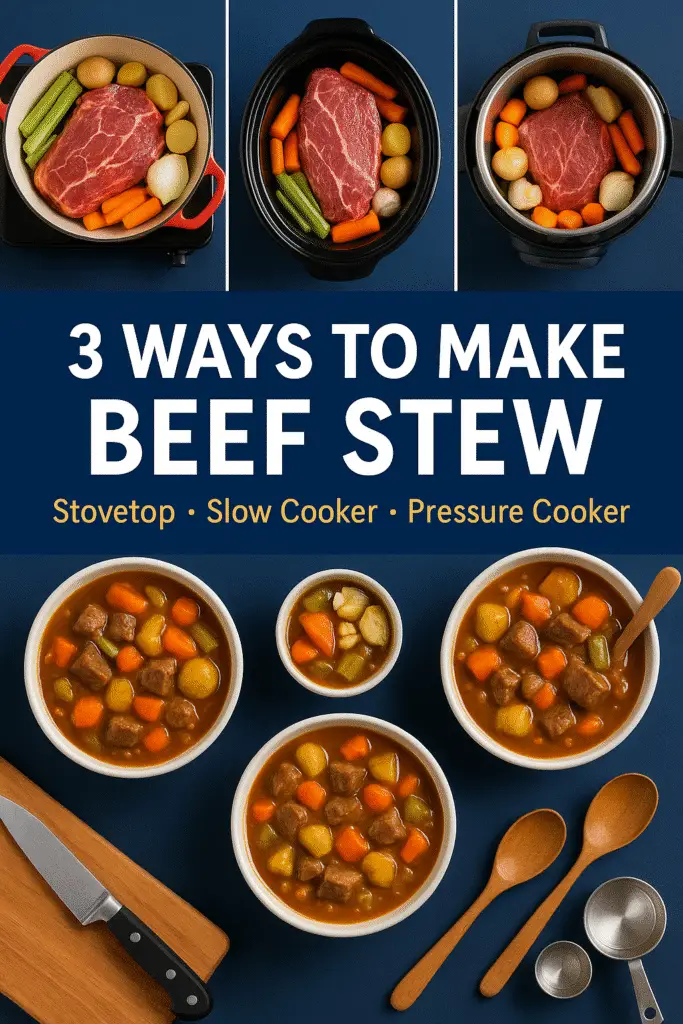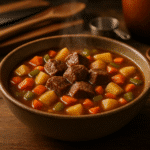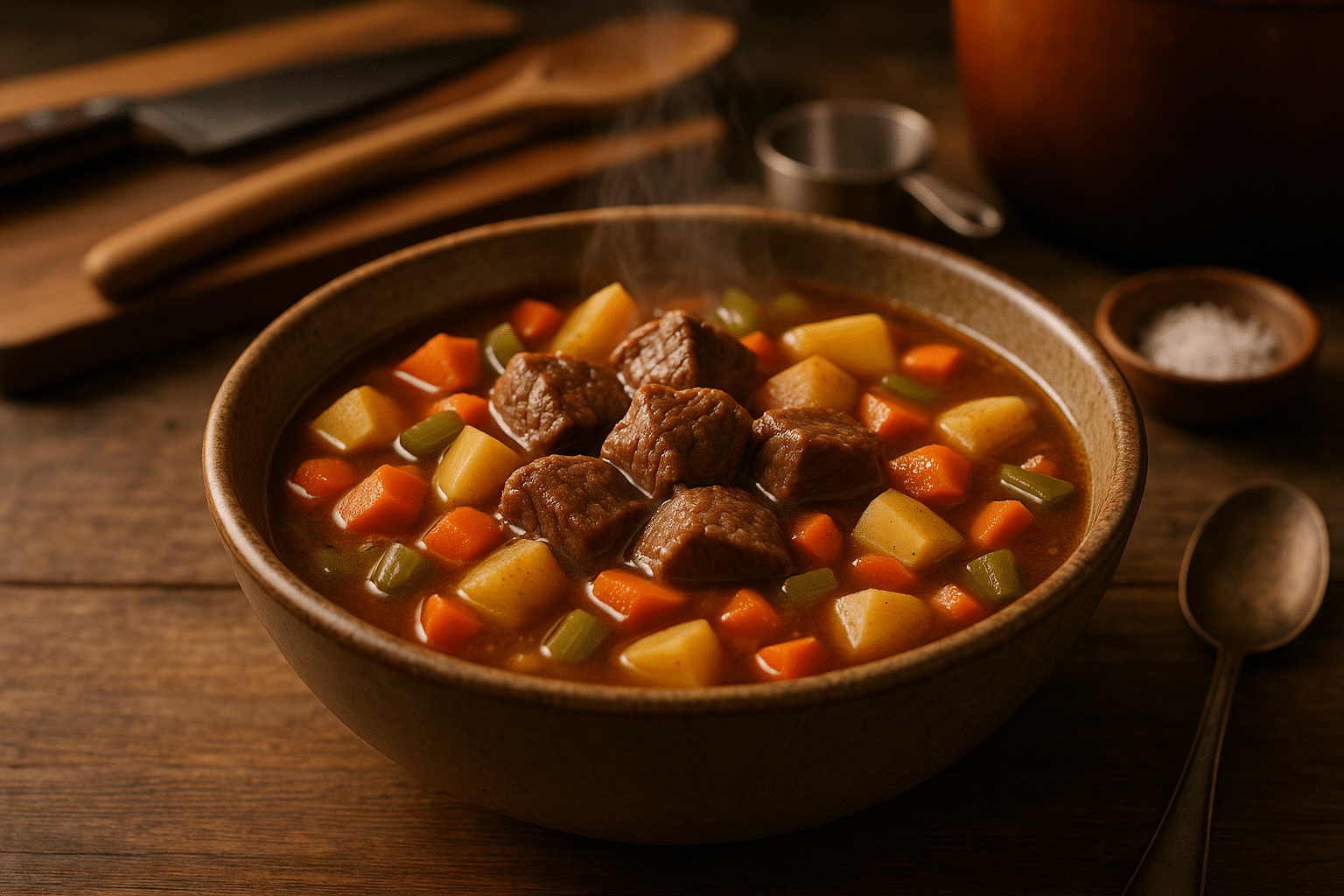When winter winds blow, nothing warms us like a classic beef stew. I’ve honed this easy recipe over years, turning simple ingredients into a heartwarming meal. My best beef stew is more than food—it’s a warm hug for the soul.
Winter needs a dish that’s both nourishing and comforting. This stew recipe offers just that, with tender meat, robust veggies, and a rich broth. It’s a one-pot wonder that makes ordinary ingredients into something extraordinary.
Key Takeaways
- Perfect cold-weather comfort food
- Simple ingredients create complex flavors
- Nutritious and filling meal
- Adaptable to various cooking methods
- Minimal prep time with maximum taste
Introduction to My Beef Stew Recipe
Beef stew is more than a meal to me. It’s a journey of warmth, comfort, and memories. Whether I’m making it in a crock pot or on the stovetop, it’s the ultimate comfort food.
Why I Love Making Beef Stew
I love beef stew for its versatility. I can make a simple recipe into a gourmet dish with a few tweaks. Its adaptability is its beauty:
- Easy to customize with different vegetables
- Suitable for multiple cooking methods
- Perfect for feeding a hungry family
The Comfort of a Warm Meal
There’s magic in a beef stew simmering on the stove. Each bubbling pot tells a story of tradition, love, and nourishment. The tender meat, hearty veggies, and rich broth create a flavor symphony that takes me back to childhood.
My beef stew is more than a recipe. It’s a warm hug for body and soul. It shows that simple meals can be the most extraordinary.
Ingredients for a Hearty Beef Stew
Making tasty beef stew starts with picking the right ingredients. My traditional beef stew recipe uses special ingredients. These turn simple items into a cozy meal.
Essential Ingredients for the Base
The best beef stew starts with top-notch ingredients. For recipes with stew beef cubes, you need a few key things:
- 2 pounds beef chuck roast, cut into 1-inch cubes
- 4 cups beef broth
- 1 large onion, diced
- 4 cloves garlic, minced
- 2 tablespoons tomato paste
- Salt and black pepper to taste
Optional Vegetables to Enhance Flavor
Add these tasty veggies to make your stew even better:
- 3 medium carrots, chopped
- 2 celery stalks, sliced
- 2 russet potatoes, cubed
- Optional: 1 cup frozen peas
Choosing the Right Cut of Beef
Not all beef is the same for stew. Chuck roast is the best for its flavor and tenderness.
| Beef Cut | Tenderness | Fat Content | Recommended for Stew |
|---|---|---|---|
| Chuck Roast | High | Medium | ✓ Best Choice |
| Sirloin | Medium | Low | ✗ Less Ideal |
| Brisket | Medium | High | ✓ Good Alternative |
Pro tip: Choose beef with good marbling for stew. The fat inside the meat makes it tender and flavorful.

Preparation Steps for Beef Stew
Making a tasty beef stew recipe begins with preparation. Whether you’re using a crockpot or stovetop, the right steps are key. They help create rich, deep flavors.
Essential Cooking Tools You’ll Need
Before starting your crock pot beef stew, get these important tools:
- Large cutting board
- Sharp chef’s knife
- Heavy-bottomed Dutch oven or large pot
- Wooden spoon
- Measuring cups and spoons
Prepping Vegetables and Meat with Precision
Even cuts mean even cooking and a great-looking stew. Here’s how to prepare:
- Cut beef into 1-inch cubes
- Chop vegetables into similar-sized pieces
- Pat meat dry with paper towels
- Season meat before browning
The Art of Browning Beef
Browning beef is key for deep flavors in your stew. Proper browning creates a delicious crust that locks in flavor.
| Browning Technique | Key Tips |
|---|---|
| Meat Temperature | Room temperature before cooking |
| Pan Preparation | Use high heat, minimal oil |
| Browning Process | Work in batches to avoid overcrowding |
By following these steps, you’ll make a mouthwatering beef stew. It will impress everyone.
Cooking Methods for Beef Stew
Choosing the right cooking method is key for a tasty beef stew. Each method has its own benefits for making a delicious stew. It’s all about finding what works best for your schedule and kitchen.

Stovetop Cooking Process
I love using a Dutch oven on the stovetop for beef stew. Brown the meat in batches for deep flavors. Slow simmering on the stovetop blends the ingredients perfectly, making a warm and satisfying meal.
- Use medium-low heat to prevent burning
- Stir occasionally to ensure even cooking
- Cook for 2-3 hours until meat is tender
Slow Cooker Instructions
The slow cooker is a lifesaver for busy cooks. Just add everything in the morning, and come home to a tender stew. It’s the ultimate “set it and forget it” recipe.
- Cook on low for 8 hours
- Ideal for tougher cuts of meat
- Minimal hands-on preparation required
Pressure Cooker Approach
The pressure cooker is great for quick meals. It cooks stew fast without losing flavor. It’s perfect for when you’re short on time but want a hearty meal.
- Cooking time reduced to 35-45 minutes
- Locks in moisture and flavor
- Perfect for last-minute dinner preparations
Enhancing the Flavor Profile
Making a great beef stew slow cooker recipe is more than just mixing ingredients. It’s about adding depth and complexity to the flavors. Choosing the right ingredients and cooking techniques are key.
The base of a fantastic beef stew is the liquid. While water is simple, beef broth makes a big difference.
Choosing the Right Liquid Base
I always use high-quality beef broth, homemade or store-bought. This broth brings all the flavors together in a perfect mix.
| Liquid Base | Flavor Impact | Recommended Usage |
|---|---|---|
| Beef Broth | Rich, Deep | Primary Liquid |
| Bone Broth | Intense, Mineral | Partial Replacement |
| Red Wine | Complex, Robust | Flavor Enhancer |
Herbs and Spices That Elevate Flavor
- Fresh thyme: Adds earthy undertones
- Rosemary: Provides aromatic complexity
- Bay leaves: Contribute subtle depth
- Black pepper: Brings gentle heat
The Transformative Role of Acid
A little balsamic vinegar or red wine can make the stew pop. Acid balances the richness of the meat, making the flavors more interesting.
With these steps, you’ll have a beef stew that’s truly special. It’s a dish that tells a story with every bite.
Ideal Cooking Time for Beef Stew
Cooking times are key for a great beef stew. The right time makes tough meat tender and delicious. Knowing the cooking times for each method ensures your stew is perfect.
The cooking method greatly affects the stew’s texture and taste. Each method needs careful timing and technique.
Cooking on the Stovetop
Stovetop cooking takes patience. Simmer your stew for about 2-3 hours. This slow cooking breaks down meat and enhances flavors.
- Use medium-low heat
- Stir occasionally to prevent burning
- Check meat tenderness after 2 hours
Slow Cooking for Tender Meat
Slow cookers make beef stew incredibly tender. Cooking on low for 6-8 hours turns tough meat into tender, fall-apart pieces.
| Cooking Method | Time | Heat Setting |
|---|---|---|
| Low Heat | 6-8 hours | Gentle, consistent warmth |
| High Heat | 4-5 hours | Faster cooking |
Pressure Cooking Time Considerations
Pressure cookers are great for those in a hurry. Stew beef meat recipes can be ready in 35-45 minutes. This method saves time without sacrificing tenderness.
- Use 1 cup of liquid
- Cook at high pressure
- Allow natural pressure release
Tips for the Perfect Texture
Getting the right texture in beef stew can be tricky. But with the right techniques, you’ll make a delicious dish every time. Whether you’re using a beef stew instant pot recipe or a traditional crock pot method, getting the perfect consistency is key to a memorable meal.
Achieving the Right Thickness
Thickening your beef stew needs careful attention. Here are a few methods to get the ideal texture:
- Use cornstarch slurry for quick thickening
- Flour dredging before browning meat
- Reducing liquid through slow simmering
- Mashing some potatoes directly in the stew
My favorite beef stew recipe from Allrecipes uses a roux. It’s made by cooking flour and butter before adding it to the stew. This method gives a rich, smooth consistency without lumps.
How to Avoid Soggy Vegetables
It’s important to prevent mushy vegetables in your stew. Here’s a strategic approach for adding different vegetables:
| Vegetable Type | Add Time | Cooking Method |
|---|---|---|
| Root Vegetables | Beginning | Slow Cooker/Instant Pot |
| Softer Vegetables | Last 30-45 Minutes | Stovetop/Pressure Cooker |
| Delicate Greens | Final 10 Minutes | Any Method |
For a beef stew recipe for crock pot, timing is everything. Layering ingredients strategically prevents overcooking and keeps vegetables intact.
Storing and Reheating Leftovers
My beef stew recipe is a hit that gets even better the next day. Keeping it stored right is key to keeping the flavors and meat tender.
Best Practices for Storage
Storing your beef stew right keeps the flavors and meat safe. Here are my top tips:
- Cool the stew completely before storing
- Use airtight containers with tight-fitting lids
- Refrigerate within 2 hours of cooking
- Store in the refrigerator for 3-4 days
- For longer storage, freeze for up to 3 months
Reheating Without Losing Flavor
Reheating beef stew needs gentle care to keep its taste and texture. I suggest these methods to keep it delicious:
- Stovetop Method: Reheat on low heat, stirring occasionally
- Microwave Option: Use medium power and stir every 30 seconds
- Add a splash of broth if the stew seems too thick
- Taste and adjust seasonings if needed
Pro tip: If the stew is too thick, add a bit of beef broth while reheating. This keeps the flavors bright and the consistency right.
Pairing Suggestions for Beef Stew
Creating the perfect homemade beef stew recipe is just the start. Finding the right sides can take your dish from good to great. The right pairings will bring out the best in your stew, making your meal unforgettable.
Delicious Side Dishes to Complement Your Stew
Choosing the right sides is key when making homemade beef stew. Here are some top picks to elevate your meal:
- Crusty Bread: Great for dipping in the savory gravy
- Creamy Mashed Potatoes: Adds a nice contrast in texture
- Fluffy White Rice: A light base for the hearty stew
- Buttered Egg Noodles: A tasty pasta option
Perfect Beverage Pairings
Finding the right drink can really boost your stew’s flavor. Here are some drinks that pair well with this classic dish:
| Beverage Type | Recommended Options | Flavor Compatibility |
|---|---|---|
| Red Wines | Cabernet Sauvignon, Merlot | Rich, bold flavors that complement beef |
| Non-Alcoholic | Robust Red Grape Juice, Dark Beer | Deep, complex taste profiles |
| Warm Drinks | Mulled Cider, Herbal Tea | Cozy, warming accompaniments |
My go-to pairing is a glass of Cabernet Sauvignon with crusty bread. The wine’s bold taste matches the stew’s rich flavors perfectly.
Variations on My Beef Stew Recipe
Exploring different variations of my classic beef stew recipe opens up a world of culinary creativity. A great irish beef stew recipe can be transformed with a few simple ingredient swaps and global inspirations.
Introducing Different Proteins
While beef is the traditional choice, experimenting with alternative proteins can bring exciting new dimensions to your stew. Consider these protein options:
- Lamb for a classic Irish-style approach
- Venison for a gamey, rich flavor
- Chicken for a lighter alternative
- Goat meat for an adventurous twist
Exploring Global Inspirations
Global cuisines offer incredible inspiration for reimagining the traditional stew. My favorite variations include:
| Cuisine | Unique Ingredients | Flavor Profile |
|---|---|---|
| Guinness Beef Stew | Dark beer, extra stout | Rich, malty undertones |
| Mexican Beef Stew | Chili peppers, cumin | Spicy, bold flavors |
| French Beef Bourguignon | Red wine, pearl onions | Elegant, complex taste |
Vegetarian Alternatives
For those seeking plant-based options, my mexican beef stew recipe transforms beautifully with vegetarian ingredients. Mushrooms, like portobello or king oyster, provide a meaty texture. Legumes like lentils or chickpeas add protein and substance, making a hearty vegetarian stew.
Ultimately, the best stew recipe is one that reflects your personal taste and culinary imagination. Don’t be afraid to experiment and make the recipe your own!
Serving Suggestions
Presenting a delicious beef stew can make a big difference. My ground beef stew recipe has several ways to make your dish look great and taste amazing.
When plating a vegetable beef stew, think creatively. I like using deep ceramic bowls to show off the stew’s colors. For a rustic look, try serving it in a warm bread bowl from traditional comfort food collections.
Creative Plating Techniques
- Use white or neutral-colored dishes to highlight the stew’s rich colors
- Serve in individual cast-iron skillets for a restaurant-style presentation
- Create height by placing stew atop a bed of creamy mashed potatoes
Garnishing for Maximum Impact
Garnishes can make your stew stand out. Here are some great options:
- Fresh chopped parsley for a pop of green
- A dollop of sour cream
- Sprinkle of fresh thyme leaves
- Crispy bacon bits for extra texture
The aim is to make a dish that looks as good as it tastes. With these tips, your beef stew will be the highlight of any meal.
Nutritional Considerations
When making an old fashioned beef stew, knowing its nutritional value is key. I aim to make a stew that’s both tasty and healthy. This means focusing on flavor and nutrition.
Beef stew is packed with good stuff. The lean beef gives you quality protein for muscles and health. Carrots, potatoes, and onions add important vitamins and minerals.
Calorie and Nutrient Breakdown
A typical beef stew has 250-350 calories per serving. It’s rich in:
- Protein: 20-25 grams per serving
- Carbohydrates: 15-20 grams
- Fat: 10-15 grams
Balancing Nutritional Content
To make your stew healthier, try these tips:
- Choose leaner beef to cut down on saturated fat
- More veggies than meat
- Use low-sodium broth
- Add kale or spinach for extra nutrients
With smart ingredient choices and portion control, you can make a beef stew that’s good for you. It supports your health goals.
Frequently Asked Questions About Beef Stew
Every home cook faces challenges when making a beef stew recipe. I’ve gathered the most common questions and answers. They will help you make the perfect insta pot beef stew recipe with confidence.
Beef stew can be tricky, but knowing common mistakes helps. Here are some mistakes to avoid:
- Skipping meat browning: Always brown your beef before slow cooking to develop rich flavor
- Using tough meat cuts that won’t tenderize
- Overcrowding the pot, preventing proper meat searing
- Adding vegetables too early, resulting in mushy texture
Creating a Gluten-Free Beef Stew
For those with gluten sensitivities, making a gluten-free beef stew is easy. Here are key strategies:
- Replace wheat flour with cornstarch or arrowroot for thickening
- Use gluten-free beef broth
- Check all seasoning packets for hidden gluten
- Verify Worcestershire sauce is gluten-free
My easy beef stew recipe can be adapted for various dietary needs. The key is understanding ingredient substitutions and cooking techniques. This way, you can keep the stew’s hearty essence.
Personal Stories Associated with Beef Stew
Food connects us to our roots and makes lasting memories. My journey with beef stew started in my grandmother’s cozy kitchen. The smell of simmering stew filled the house with warmth and comfort.
Our family’s beef stew tradition is a cherished ritual passed down through generations. We’ve tried different cooking methods, from stovetop to crock pot. Each method tells a story of adaptation and love.
Family Recipes Passed Down
Our beef stew recipe has changed over time, with each generation adding their own twist. My mother taught me how to make a rich, hearty stew in a slow cooker. This method ensures tender meat and deep flavors.
- My grandmother’s original recipe used beef chuck and root vegetables
- My mother introduced red wine for added depth
- I now experiment with different herbs and spices
Memorable Moments with Friends
Sharing beef stew with friends has given me some of my most treasured memories. Winters are always better with a big pot of stew and good company. Whether it’s a casual dinner or a weekend gathering, this dish brings people together.
I encourage everyone to start their own beef stew traditions. Begin with a simple recipe, make it your own, and watch it become a cherished memory for your loved ones.
Conclusion and Final Thoughts
Making the perfect beef stew is an art that mixes skill, passion, and creativity. My exploration of easy crock pot beef stew recipes showed that cooking is about understanding basic principles, not strict rules. Every time I make slow cooker beef stew, I find new ways to improve the taste and texture.
Recipes with beef stew meat are very flexible for home cooks. The dish’s beauty is in its ability to adapt – from old methods to new ingredient mixes. Whether using a pressure cooker, slow cooker, or stovetop, the goal is the same: to make a comforting meal that warms both body and soul.
I suggest seeing this recipe as a starting point for your cooking journey. Try different herbs, spices, and proteins. Your special touch will make a simple recipe a family favorite. The best meals come from fun kitchen experiments and trusting your instincts.
Remember, cooking is a journey of learning. Each try brings you closer to your perfect beef stew. Enjoy the process, share your dishes with family, and most importantly, savor every delicious moment in the kitchen.
FAQ
What’s the best cut of beef for making stew?
Chuck roast is the top choice for beef stew. It’s tough but gets tender when slow-cooked. This makes it rich in flavor and soft to the bite. Choose well-marbled pieces for extra moisture.
Can I make beef stew in a slow cooker?
Yes, slow cookers are great for beef stew. Brown the meat first for deeper flavors. Then, put it in the slow cooker. Cook on low for 7-8 hours or high for 4-5 hours until it’s tender.
How can I thicken my beef stew?
You can thicken beef stew in several ways. Use flour or cornstarch to make a slurry, add a roux, or simmer uncovered. My favorite is mixing cornstarch with cold water and stirring it in during the last 30 minutes.
How long can I store beef stew in the refrigerator?
Beef stew can be stored in the fridge for 3-4 days. Cool it down before refrigerating. Always reheat to 165°F to stay safe.
Can I freeze beef stew?
Yes, beef stew freezes well! Store it in freezer-safe containers. It lasts up to 3 months. Thaw in the fridge and reheat gently, adding broth if it’s too thick.
What are some good side dishes to serve with beef stew?
Serve beef stew with crusty bread, creamy mashed potatoes, or rice. A green salad or roasted veggies also pair well, balancing the stew’s rich flavors.
How can I make my beef stew gluten-free?
For gluten-free stew, use cornstarch or arrowroot powder instead of flour. Choose gluten-free broth and tamari if needed. Always check labels for gluten.
What herbs work best in beef stew?
Thyme, rosemary, and bay leaves are great in beef stew. Use fresh thyme and a bay leaf during cooking. Garnish with parsley for a fresh touch.

Beef Stew Recipe: The Ultimate Guide to Perfect Comfort Food
- Total Time: 2 hours 50 minutes
- Yield: 6 servings 1x
Description
The ultimate comfort food recipe featuring tender beef chuck roast, hearty vegetables, and rich broth. Perfect for cold weather and family gatherings.
Ingredients
2 pounds beef chuck roast, cut into 1-inch cubes
4 cups beef broth
1 large onion, diced
4 cloves garlic, minced
2 tablespoons tomato paste
3 medium carrots, chopped
2 celery stalks, sliced
2 russet potatoes, cubed
Salt and black pepper to taste
1 cup frozen peas (optional)
2 tablespoons olive oil for browning
1 teaspoon fresh thyme
2 bay leaves
Instructions
1. Pat beef cubes dry and season with salt and pepper
2. Heat olive oil in Dutch oven over medium-high heat
3. Brown beef cubes in batches, about 3-4 minutes per side
4. Remove beef and set aside
5. Sauté onions in same pot until translucent, about 5 minutes
6. Add garlic and cook for 1 minute until fragrant
7. Stir in tomato paste and cook for 2 minutes
8. Return beef to pot and add beef broth
9. Add thyme and bay leaves, bring to boil
10. Reduce heat to low, cover and simmer for 1.5 hours
11. Add carrots, celery, and potatoes
12. Continue cooking for 45-60 minutes until vegetables are tender
13. Add frozen peas in last 10 minutes if using
14. Remove bay leaves before serving
15. Taste and adjust seasoning as needed
Notes
Chuck roast is the best cut for tender, flavorful stew
Can be made in slow cooker: cook on low 7-8 hours or high 4-5 hours
For pressure cooker: cook 35-45 minutes at high pressure
Stew improves in flavor overnight – great for meal prep
Can be frozen for up to 3 months
Add acid like balsamic vinegar for enhanced flavor
- Prep Time: 20 minutes
- Cook Time: 2 hours 30 minutes
- Category: Main Course
- Method: Braising
- Cuisine: American
Nutrition
- Serving Size: 1 bowl (approximately 1.5 cups)
- Calories: 320
- Sugar: 8g
- Sodium: 890mg
- Fat: 12g
- Saturated Fat: 4g
- Unsaturated Fat: 8g
- Trans Fat: 0g
- Carbohydrates: 22g
- Fiber: 4g
- Protein: 25g
- Cholesterol: 75mg

